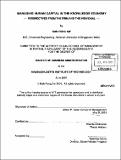| dc.contributor.advisor | Wanda Orlikowski. | en_US |
| dc.contributor.author | Aw, Kah-Peng, 1967- | en_US |
| dc.contributor.other | Sloan School of Management. | en_US |
| dc.date.accessioned | 2005-08-23T16:10:39Z | |
| dc.date.available | 2005-08-23T16:10:39Z | |
| dc.date.copyright | 2001 | en_US |
| dc.date.issued | 2001 | en_US |
| dc.identifier.uri | http://hdl.handle.net/1721.1/8893 | |
| dc.description | Thesis (M.B.A.)--Massachusetts Institute of Technology, Sloan School of Management, 2001. | en_US |
| dc.description | Includes bibliographical references (leaf 55). | en_US |
| dc.description.abstract | This thesis examines the challenges and implications of managing human capital in a knowledge-intensive environment from the perspectives of both the firm and the individual. Knowledge is redefining the operating environment and competitive landscape for individuals, businesses and nations. The knowledge economy that has emerged is one that is differentiated by the characteristics of speed, connectivity, complexity, continuous learning and intangibility. The knowledge assets of a firm is the aggregate of its human capital, structural capital, customer capital and the value that the interaction of these components produces. As firms transition into the knowledge economy, their primary challenge will lie in developing the ability to recognize, capture and exploit the value of knowledge assets. The Human Capital Management Model provides a framework for examining and integrating the broad range of issues surrounding human capital management. By taking an approach that involves reshaping the entire firm, the model suggests that a firm progress through six stages in the build up of an infrastructure for sustained human capital development. Each stage is correlated with higher returns from human capital. The six stages involves assessing and differentiating human assets, re-organizing work, recasting and understanding new roles, putting in place a performance measurement and reward system, enhancement and growth through continual investments, and lastly establishing trust as the ·basis for integration of human, structural and customer capital. The same forces that are reshaping the way that firms manage their human capital will impact how an individual views his own career and its management. First, careers are repositories of knowledge. Next, continuous learning is the primary means for renewal and upgrading of human capital. Third, career management is a series of risk management choices, where the rate of return determines the range of future choices. Finally, individuals will assume the primary responsibility for career direction and progression. | en_US |
| dc.description.statementofresponsibility | by Kah-Peng Aw. | en_US |
| dc.format.extent | 55 leaves | en_US |
| dc.format.extent | 3966043 bytes | |
| dc.format.extent | 3965804 bytes | |
| dc.format.mimetype | application/pdf | |
| dc.format.mimetype | application/pdf | |
| dc.language.iso | eng | en_US |
| dc.publisher | Massachusetts Institute of Technology | en_US |
| dc.rights | M.I.T. theses are protected by copyright. They may be viewed from this source for any purpose, but reproduction or distribution in any format is prohibited without written permission. See provided URL for inquiries about permission. | en_US |
| dc.rights.uri | http://dspace.mit.edu/handle/1721.1/7582 | |
| dc.subject | Sloan School of Management. | en_US |
| dc.title | Managing human capital in the knowledge economy : perspectives from the firm and the individual | en_US |
| dc.type | Thesis | en_US |
| dc.description.degree | M.B.A. | en_US |
| dc.contributor.department | Sloan School of Management | |
| dc.identifier.oclc | 48855203 | en_US |
